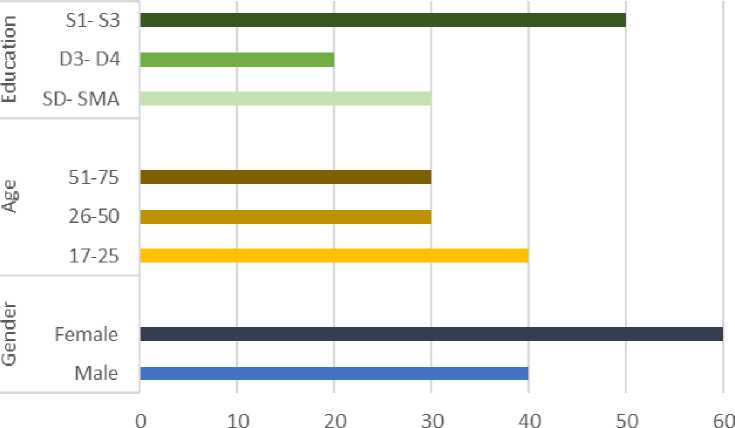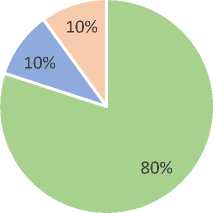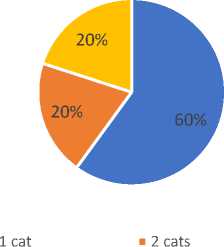A CASE STUDY OF CAT STERILIZATION IN KARANGWUNI, YOGYAKARTA: IMPACTS PERCEIVED BY CARETAKERS AND THEIR UNDERSTANDING OF THE PROGRAM
on
Volume 15 No. 5: 964-970
Oktober 2023
https://doi.org/10.24843/bulvet.2023.v15.i05.p33
Buletin Veteriner Udayana
pISSN: 2085-2495; eISSN: 2477-2712
Online pada: http://ojs.unud.ac.id/index.php/buletinvet
Terakreditasi Nasional Sinta 4, berdasarkan Keputusan Direktur Jenderal
Pendidikan Tinggi, Riset, dan Teknologi No. 158/E/KPT/2021
A Case Study of Cat Sterilization in Karangwuni, Yogyakarta: Impacts Perceived by Caretakers and Their Understanding of The Program
Khalisya Anjani Putri1*, Winaya Satasya Tippy2, Janice Viary3
1Jakarta Animal Aid Network, Gunung Sindur, District of Bogor, West Java, Indonesia; 2Student of The Royal (Dick) School of Veterinary Studies, University of Edinburgh, Easter Bush Campus, Midlothian EH25 9RG, England;
3Graduate Research Assistant at University of Illinois Urbana-Champaign, Champaign, IL, USA.
*Corresponding author email: drh.cica@jaandomestic.com
Abstract
There is yet to be collected the number of cats in Indonesia, including free- roaming cats. Studies have shown that there is a connection between sterilization and free-roaming cats’ health and welfare. In 2021, Suara Suaka Indonesia decided to hold a small-scale sterilization program in a neighborhood called Karangwuni, Yogyakarta to contribute in lowering cat population. In this case study, we focus on the effect of sterilization to cats that are perceived by humans. Survey was done using Google Forms, taking information on their demographics, involvement with Suara Suaka Indonesia, feedback on their cats’ post-surgery changes and their understanding on sterilization. Respondents are generally satisfied with the impact sterilization has on them and their cats, this is supported by how they perceive sterilization as important and their willingness to recommend the procedure to other people. However, there can still be improvement on delivering messages of sterilization to ensure that the purpose, process, and impact of sterilization can be adequately understood by all participants of the program.
Keywords: free-roaming cats; qualitative; sterilization; TNR
This article was presented at the Animal Welfare Indonesia 1st Conference 2022 seminar organized by JAAN supported by FOUR PAWS on December 14 2022, and has passed selection and review by the seminar editorial team. Buletin Veteriner Udayana published this article under a cooperation contract between Udayana University and JAAN.
INTRODUCTION
There is yet to be collected the number of cats in Indonesia, especially free-roaming ones. In Yogyakarta’s traditional markets particularly, there are approximately around 10.000 stray cats (Pandangan Jogja, 2022). Free-roaming cat populations have always been an ongoing issue but there has yet to be a governmental body that regulates their population control, at least in Indonesia. The Trap- NeuterReturn, as a method of control in many parts of the world, has been scientifically argued to be ineffective in significantly reducing the number of cats in a population (Lepczyk et al., 2022), and yet the method appeals to many for its non-lethal outcome and its promised solution when it is done in
a large scale (Crawford et al., 2019). Sterilization itself, however, has provided real- life benefits for humans and cats which encompasses health and behavioral benefits (Crawford et al., 2019); prevention of unwanted (dead or alive) kittens, reproductive organ-related disease, aggression, and roaming.
Free-roaming cats are generally vulnerable to parasite infections and naturally occurring viral diseases as they are continuously exposed to pathogens. Interaction with cats acting as ectoparasite and feline virus hosts also contributes to the widespread of such diseases on the street. Thus, cats that live in highly-populated area are in danger of such risks, whether they are owned or not (Crawford et al., 2019).
In 2021, Suara Suaka Indonesia (SSI) decided to hold a small-scale Trap- NeuterReturn (TNR) program in a neighborhood called Karangwuni, Yogyakarta. There were around 4 groups of cats sterilized in a span of 7 months. There were 38 cats sterilized, 12 males and 26 females which comprised of both street and owned indoor and outdoor cats. We had planned originally to focus on one neighborhood but later-on more cat owners reached us out from outside of the neighborhood. The intention of this program was to reduce the number of cat population in Karangwuni, by reducing the number of intact males and females in order to prevent unwanted kittens living on the street or dead by disease. However, due to time constriction and lack of planning, we were unable to sterilize all the free-roaming cats in the neighborhood.
In this case study, we decided to focus on the effect of sterilization on cats that are perceived by their caretakers and their perception and knowledge of sterilization by collecting responses from our program's participants. We would like to see whether sterilization fulfills the expected changes caretakers have and the knowledge they will gain after joining the program.
RESEARCH METHODS
Research Design
Survey was done using Google Forms, taking information on their demographics, involvement with Suara Suaka Indonesia, feedback on their cats’ post-surgery changes and their understanding on sterilization (Figure 1). Aside from the demographics, all the questions are written in an interrogative manner. Out of 15 surveys we have shared, only 10 responded with answers. The survey was carried out in Bahasa Indonesia.
There are three sections in the survey. Firstly, we took the caretakers' personal information for demographics data. On the second section we focused on their involvement with SSI. Lastly, we asked their opinion on the cats’ changes and their
understanding on why sterilization is impactful.
Data Analysis
Analysis was done by comparing our results to existing journals that can determine, support, and oppose our results.
RESULTS AND DISCUSSION
Demographics
The ten respondents of our survey comprised of 6 females and 4 males (Figure 1), 40% of them are young adults (age 17 to 25), 30% are adults (age 26-50) and the rest are older than 50 (age 51- 75). 50% of the respondents are known to have completed a Bachelor’s degree or higher, while 30% of them do not complete a tertiary education. Two respondents are known to be a Diploma graduate.
The act or decision to sterilize a pet cat is believed to have a correlation on the owner’s age, gender, educational background and occupation (McKay et al., 2009). Our results are consistent with the outcome of the study by McKay et al. (2009), that female owners are more likely to sterilize their pets. Male owners are known to be more concerned of sterilization as they are wary of their pets losing their sexual identity. However, there is also a possible cultural impact. In Indonesia, the men of the family have the tendency to be the breadwinner, making them frequently away from the house while the women stay at home. Thus, women tend to be more receptive with the house and the neighborhood situation. This can be an alternative reason why there are more females involved in our sterilization program as it happens that we directly approached cat owners to their home.
Another result of McKay et al. (2009) research that align with ours is that people with higher qualifications in education are very likely to sterilize their pets. This is partially true for our survey, respondents with an elementary to high school qualification are higher in number than those that had finished a Diploma. This
might be due to the lack of large simple size,
Young adults are seen to be more in number than adults that are older than 26 years old. A possible reason for this might be because younger people are more exposed and concerned to welfare issues (Driscoll, 1992) and thus might be less hesitant to sterilize their cats.
According to our survey, 40% of the respondents are working at private sectors while 30% of them are housewives (Table 1). The rest of the respondents are working as a university lecturer, a freelancer, and a student. This complements with the cultural impact previously mentioned, considering one of the private employees is based at home. Other occupations listed might have more travel in their line of work.
Information of the Cats
Respondents were asked on the type of cats they have (Figure 2) and how many cats they have that were sterilized by our group (Figure 3). Survey shows that 80% of the respondents own indoor cats, 10% of them have own cats outdoor and the rest only take care of the stray cats. 60% of the respondents have only one cat, 20% of them have two cats and the rest own more than 3 cats.
Respondents were also asked on why they joined the TNR program we held (Table 2) which we encouraged them to give open-ended answers. This allowed them to give multiple reasons why. Most respondents sterilized their cats to ‘prevent them from reproducing’ and hence, eliminating kittens’ existence which will decrease the population growth. A few of them gave similar answers that are directed to ‘a better health condition’. Only a small number of respondents have ‘prevention of animal cruelty’ and ‘better welfare’ as answers. Respondent perceives sterilization as a way ‘to be less bothered’ in taking care of unwanted kittens.
Most responses reflect the primary purpose of cat sterilization which is population control. It is well-known that cats perform actions that negatively affect
the environment, this includes preying on wildlife, littering, and fighting on the neighbor’s yard (Grayson and Calver, 2004). The rapid growth of cat population could significantly increase the magnitude of negative effect in a short period of time. We believe that sterilization for health and behavioral benefits come secondary to preventing unwanted kittens, as complemented on the study by Wongsaechan and McKeegan (2019). This is also reflected by our results which happens to have intention referring to population control as the most frequently mentioned, with health reasons as second and unwanted behaviors as third.
One respondent had raised ‘prevention of animal cruelty’ as one of their purposes to sterilize their cats, this highlights a citizen’s awareness of animal cruelty that correlates to the overpopulation in the streets of Indonesia (Basiroen and Hartady, 2019). Animal cruelty and abandonment have consequences that can be impactful to cats, humans, and the environment (Perdomo et al., 2021) Another respondent answered ‘good animal welfare’ as a purpose of sterilization. This can be deciphered in many ways; prevention of unwanted kittens, which brings the chance of kittens suffering on the streets to zero, prevention of suffering for the species as a whole, or prevention of reproductive organ-related diseases. Lastly, a respondent replied that they want to sterilize their cats in ‘prevention of unwanted kittens’ due to their lack of intention to take care of the kittens. This can lead to abandonment, which is a form of animal cruelty.
All of the 10 respondents were asked whether there were any changes experienced by their cats that they have seen post- sterilization. All of them answered yes and we asked them to mention the changes that visually stood out to them. Most responses encompass answers that can be linked to ‘better health condition’ as they mentioned ‘cats being healthier’ and an ‘increasing in weight’. Another two popular answers indicate a
change in behavior. Firstly, cats are seen to be more ‘approachable’ and ‘calmer’. Secondly, they ‘stay at home more’ and have less frequency of roaming. Thirdly, cats are less vocal which might indicate the lack of biological need to mate. Respondents also gave a few answers that indicates the sterilization impacts on cats’ population growth and indirectly the cleanliness of the neighborhood.
Contrary to the intention of sterilization, the primary benefit of sterilization that is highly visible in human eyes are body condition score and behavioral changes. These sterilized cats experience an increase in weight. A study by Nguyen et al. (1999) found that there is lack of differences in the activity level between intact and neutered cats, but food intake was found to be higher in neutered cats than the others (Flynn et al., 1996) as intact cats was seemed to self-regulate their intake. However, weight gain can be a problem if it is not supervised by the owners. Some owners might take their cat increase in size as a sign that they are healthier, but it is not the suitable indicator of health in sterilized cats as they are prone to obesity. However, in feral cats, Body Condition Score can be a method of judging their overall health and welfare (Scott et al., 2022).
Testosterone-dependent behavior such as mating call and spraying were found to be reduced after being neutered and thus opposing genders no longer becomes a trigger of aggression, female cats also no longer perform mating call after they are sterilized (Cafazzo et al., 2019). Resource aggression, however, still occurs when they are faced with it. People also observed that there was less aggression in their cats and study has proven that neutering can prevent fighting and disease that are transmitted through bite wounds like FIV (Hosie et al., 2009). Scott et al. (2022) stated that caretakers of outdoor cats reported that they roamed much less than they were before sterilized, something that was also visible in our results. However, there were no
systematic method on how they have taken such testimony from the caretakers. This is also against what Nguyen, Duncan and Martin (1999) stated about activity level. In addition, Scott et al. (2015) also stated that there are other variables to be considered in determining the changes in a cat’s ranging activity, which was not being done on their paper.
Two respondents mentioned reasons that refer to prevention on unwanted kittens which in itself is the primary purpose of sterilization. Such effect can be experienced on an individual level. However, real impact needs more time and a thorough planning of sterilization to be able to confidently say that sterilization program creates a significant change on the population level.
One respondent mentioned a good level of environment’s cleanliness as a result of population control. Street cats often mark their territories with their excretion, including spraying and this can be reduced or even eliminated by sterilization (Cafazzo et al., 2019). A steady number of populations can also limit the number of scavenging for food from the trash which can be a nuisance to the environment surrounding assuming that the number of resources in an area satisfies the number of cats in a population.
Owner’s Knowledge
Figure 4a summarizes how important sterilization is for cat owners or cat guardian. 70% of the respondents feel that it is important while the rest feels that it is very important. Figure 4b shows that more than half of the respondents have an average understanding of sterilization while 30% of them still not have enough understanding. Only 10% of them responded that they have adequate understanding. Figure 5a shows that majority of the respondents will recommend sterilization for cats to their surroundings and majority of them will consider to sterilize the next cat they will have (Figure 5b). 20% of them are still
unsure but there were no respondents that reject the idea of sterilization in the future.
Based on our results, most of the respondents’ intention of sterilization were fulfilled. Respondents are generally satisfied with the impact sterilization has on them and their cats, this is supported by how they think sterilization is important and the chance of them recommending the surgery to other people. However, there can still be improvement on delivering messages of sterilization to ensure that the purpose, process and impact of sterilization can be adequately understood by all participants of the program. This improvement might be able to make all participants certain on sterilization for the years to come.
CONCLUSION AND SUGGESTIONS
Conclusion
Sterilization, be it a TNR program or done individually on indoor cats have positive impacts not only to cats but also humans. Participants of the program had also shared their understanding level on sterilization, which can be an indicator that a real- life evidence of the impact can be a step forward in inviting people to sterilize their cats. Thus, more awareness about the importance of sterilization needs to be conveyed to the public in order to make a real impact on stray cats’ overpopulation.
Suggestions
This study case focuses on qualitative observations and interpretation. It requires statistical interpretation that can have valid and legitimate results, especially the correlation between all survey questions as we do not have one. The sample size we acquired is also not enough to provide accurate comparisons with existing journals despite of having a few of our results align to some theories. There is also a lack of presterilization survey that could have given a higher level of eligibility on the changes we are looking at. Lastly, there is a large timegap between the sterilization and survey,
changes observed and collected might have been impacted by other external variables.
This study case can be used for future references of TNR program and more advanced qualitative research on
sterilization impacts, especially in
Indonesia that is having an overpopulation of cats. Research on how mass sterilization can have an impact on humans’ lifestyle, including our social and economic state, as our interaction with street cats have become a part of our everyday life.
REFERENCES
Basiroen VJ, Hartady N. 2019. Peduli sobat ekor: A social campaign about
responsibility towards abandoned pets. Int. J. Sci. Technol. Res. 8(8): 160-163.
Cafazzo S, Bonanni R, Natoli E. 2019.
Neutering effects on social behaviour of urban unowned free-roaming domestic cats. Animals. 9(12): 1105.
Crawford HM, Calver MC, Fleming PA.
2019. A case of letting the cat out of the bag why trap-neuter-return is not an ethical solution for stray cat (felis catus) management. Animals. 9(4): 171.
Driscoll J. 1992. Attitudes towards animal use. Anthrozoos. 5: 32-39.
Hosie MJ, Addie DD, Belák S. 2009. Feline immunodeficiency: ABCD guidelines on prevention and management. J. Feline Med. Surg. 11(7): 575-584.
Lepczyk CA, Duffy DC, Bird DM. 2022. A science-based policy for managing free-roaming cats. Biol. Invasions. 24: 36933701.
McKay SA, Farnworth MJ, Waran NK.
2009. Current attitudes toward, and incidence of, sterilization of cats and dogs by caregivers (owners) in Auckland, New Zealand. J. Appl. Anim. Welfare Sci. 12(4): 331-344.
Pandangan Jogja. “Pemilik Tak Tanggung Jawab, 10.000 Kucing Telantar Di Pasar Tradisional Jogja.” Pandangan Jogja, 7 June 2022,
kumparan.com/pandangan-jogja/pemilik-tak-tanggung-jawab-10-
000-kucing-telantar-di-pasar-tradisional-jogja-1yE4uXVCK7k/full.
Scott KC, Levy JK, Gorman SP. 2022. Body condition of feral cats and the
effect of neutering. J. Appl. Anim. Welfare Sci. 5(3): 203-213.

Percentage
Figure 1: Respondents demographics in the form of percentages

I have an indoor cat ■ I have an outdoor cat
There is only a street cat I don't have a cat

■ 3 cats more than 3 cats
■ Not sterilized by SSI
Figure 2 shows the respondents’ answers on whether they have a cat which refers to the cat’s living situation. Followed by figure 3 that shows the respondents’ answers on the number of cats they own or take care of, that were sterilized by Suara Suaka Indonesia.
Table 1: List of respondents’ occupation
|
Occupation |
Amount |
|
University Teacher Private employee Housewife Freelance Student |
1 4 3 1 1 |
Table 2: Respondents’ answers on their purpose of cat sterilization.
|
Keywords |
Mentioned … |
times |
|
Prevent overpopulation |
5 | |
|
Better health for the cats |
3 | |
|
Prevent unwanted sexual behavior |
1 | |
|
Prevent animal cruelty |
1 | |
|
Better welfare for the cats |
1 | |
|
Less bothered about unwanted kittens |
1 |
Table 3: Respondents’ answers when asked to specify what kind of health or behavioral related changes observed on their cats after the sterilization.
Keywords Mentioned … times
Docile behavior 6
Healthier-looking cats 3
Less roaming 2
Less overpopulation, less unwanted kittens born 2

■ Very Important ■ Important
■ Little importance Not imporant ■ Adequate ■ Average ■ Below Average ■ Very poor
Figure 4a shows the respondents’ stand on how important cat sterilization is. Figure 4b shows the respondents’ understanding on cat sterilization.

■ Yes ■ No ■ Maybe

■ Yes ■ No ■ Maybe
Figure 5a shows whether respondents’ will recommend cat sterilization to their surroundings.
Figure 5b shows whether they are considering to sterilize a cat they will have in the future.
970
Discussion and feedback